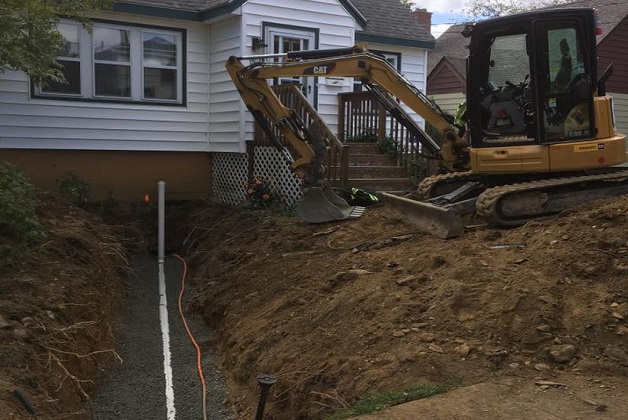
A lateral is the sewer pipe that connects your home to the main sewer line under the street. This is often a 4-inch pipe that is buried in a properly constructed, sloped trench, below the frost line. The slope is the most important part of the trench as it determines how effectively the pipe drains using gravity.
Finish Grade Excavation’s standard installation procedure for a new sewer lateral may be divided into five main parts. In this piece, we will go into further detail on these crucial actions.
Identifying the length of the pipe and the height of each end of the pipe is the first important step in installing our sewer line. In a domestic installation, the sewer pipe usually begins where the main drain for the house emerges from the building’s foundation. The line then descends in elevation to the main city sewer line.
The first slope estimates are done using the elevations and the pipe run length. The total elevation change is calculated by deducting the finishing elevation from the beginning elevation. The slope may be calculated by dividing the drop by the pipe’s whole run.
In most places, laterals must have a minimum slope of 2%, or 2 feet per 100 feet of run. The real slope can be a little bit steeper than this objective as long as it still complies with local regulations. Too steep of a slope will allow the liquids to flow more quickly than the particles, resulting in blockages. Too shallow of a slope does not provide enough velocity for effective drainage.
Trenching for a sewer pipe needs to be done properly to avoid needless soil disturbance. To reduce settling, any disturbed soil is tightly compacted. To minimize soil disturbance, it is usually better to keep the trench as narrow as possible, but doing so necessitates knowing exactly where the pipe will end. Sometimes digging a deeper hole is required.
We make sure the trench bottom is level, compacted, and follows the appropriate slope. To give the pipe constant support, a bedding material, usually sand, is laid in the trench. The slope may be adjusted before the pipe is placed since sand slopes much more easily than dirt.
Installing sewer pipes normally involves moving up to the higher elevation from the lower end of the pipe run in sections. PVC sewage pipe used nowadays is linked either with solvent adhesive or gasketed fittings. 4 inches is the typical pipe size for residential lines. The pipe material and size requirements are outlined in the municipal code.
Each pipe section’s bell (female) end is angled upward to reduce the likelihood of leaks at the pipe couplings. As required by the city, the pipe is connected to the main street. Most regulations provide for one or two cleanouts at the home end to make it simple to access the pipe for scoping or cleaning with a sewer auger.
We complete the project by backfilling the trench once the sewer lateral has been entirely installed and has passed the final inspection. Gravel is frequently used as a protective barrier around pipes before backfilling to fill in any gaps. After that, layers of earth are put into the trench. To avoid further settling, each soil layer is compacted.
Crews are made aware of the pipe’s location so that any excavation in the vicinity will not accidentally harm it.
A properly built sewer line for your property ensures that you or your renters may live there without worry. Are you unsure about where to have your sewer line installed? Your initial call should be to Finish Grade Excavation in Halifax. We excel in all we do because we carefully evaluate every element, including the frost line, minimum slope, sewer line and the length of pipe. Contact us today!